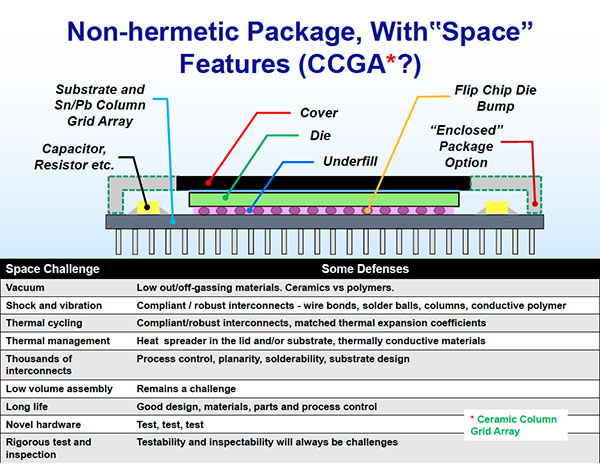Class Y: A New Class of Microcircuits for Space and Military
Like many other areas, the technology of packaging electronic parts is seeing rapid advancement. NASA is looking at ways to incorporate some of these new and emerging technologies into its systems with the introduction of a new class of microcircuits, Class Y.
The introduction of this new classification allows NASA and other space agencies to use more advanced complex microcircuits that require high-density, interconnected packages.
“We see this as an opening [for NASA and the space industry] to a new category of parts,” stated Shri Agarwal, program manager at NASA’s Jet Propulsion Laboratory (JPL) and lead for the G-12 Task Group assigned to support the development of Class Y.
Previously, NASA preferred to use hermetic packages for critical applications in space. Hermetic packages, which are made of metals, ceramics and glass, are rigid packages that have an airtight seal. Hermetic packages were preferred because only three tests were required to provide assurance of the package’s integrity. Non-hermetic microcircuits, on the other hand, have been traditionally hard to assess, and non-hermetic packages may expose multiple material interfaces.
However, new packaging needs, such as the need for three-dimensional packages to accommodate stacked-chip assemblies, require the use of mixed-material, non-hermetic packaging.
Reliability Engineer Jack Shue explained these new needs. “If we think of our circuit cards as a city, our present printed circuit assemblies are like Los Angeles. Los Angeles is spread out and this means we can no longer get a signal from one end to the other in the time allowed. One way to get things even closer is to start building up, and not out, so that our circuit board is like New York City.”
To address these three-dimensional needs, NASA’s Goddard Space Flight Center’s Michael Sampson proposed and supported the development of a new category of space-level, non-hermetic military microcircuits: Class Y.
“Complex microcircuit technology doesn’t lend itself to the traditional hermetic-sealed production processes,” explained Sampson. “We made a considerable departure from tradition with Class Y.”

Diagram of an Example of a Class Y Package
The development of Class Y was facilitated by the TechAmerica (now SAE) G12 government-industry committee and became an international effort led by NASA to infuse new technology into space-level military requirements. This is the first new class to be introduced in over 20 years.
On Dec. 20, 2013, the Defense Logistics Agency released Revision K of microcircuit specification (MIL-PRF-38535), which incorporated Class Y. Its official introduction permits companies to certify to Class Y and later qualify products to Class Y.
“Class Y will be a new tool for us to use allowing us to continue to push the limits of our designs,” stated Shue. “We are always looking for ways to make items faster, both in terms of operating speed, but also in construction. Class Y will help us continue to get higher data rates, and even more sensitive circuits so we will be able to see things we were never able to see in the past.”
The introduction of Class Y required a new concept, the development of new test methods, and the updating of existing standards. Because working with the much more fragile non-hermetic package requires a more complex testing process, Sampson conceived an innovative process for demonstrating packaging integrity specifically for Class Y non-hermetic microcircuits. Work is still continuing on the new class.
“Work continues incorporating lessons learned from the initial implementation of the new class,” said Sampson.